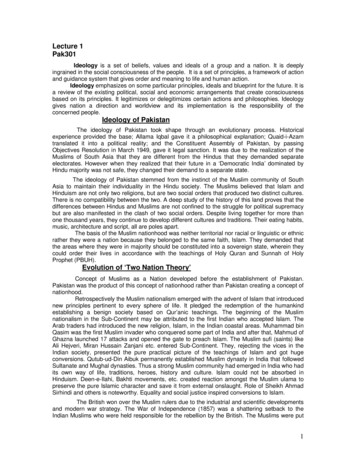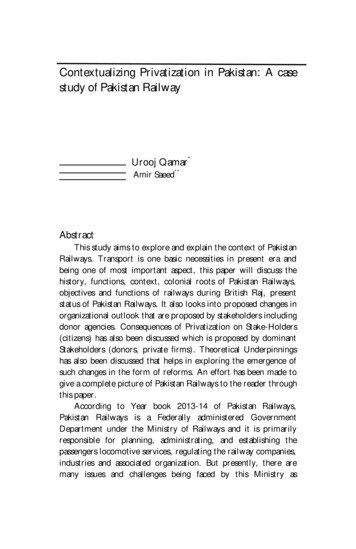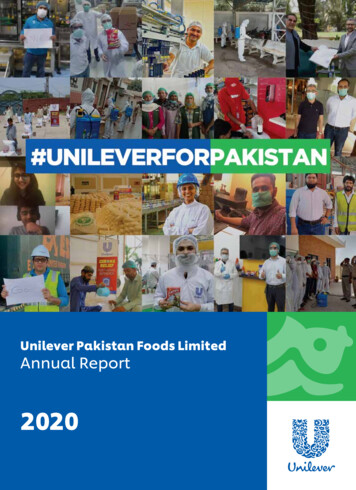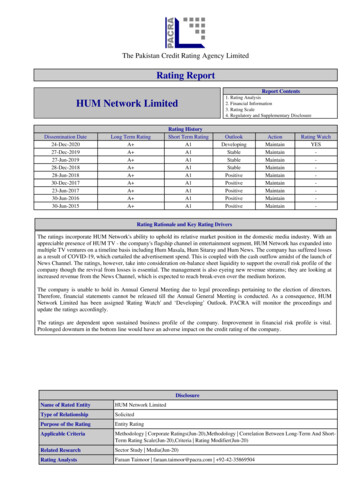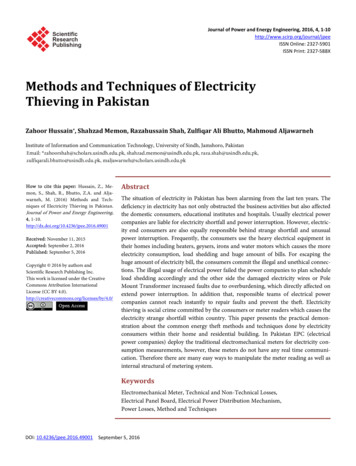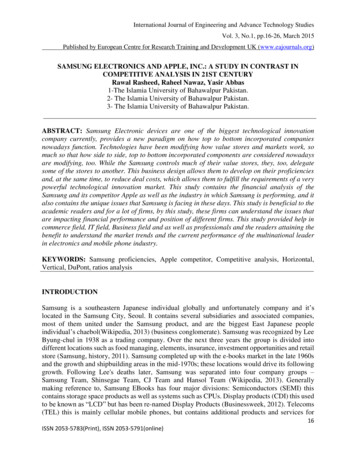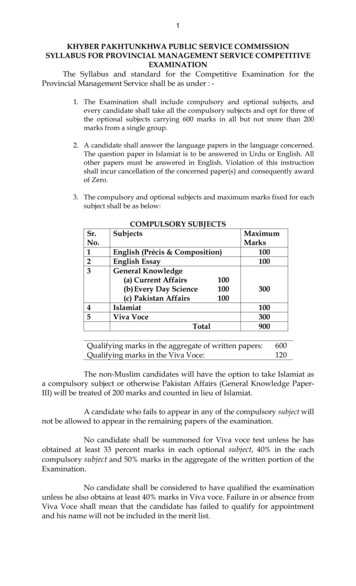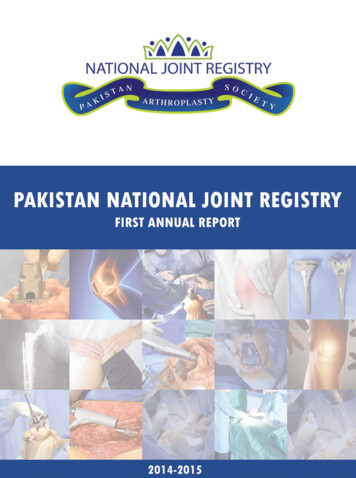
Transcription
PNJR Report 2014-15ThemeChallenges in EstablishingNational Joint Registry in aDeveloping CountryAnnual Report of Pakistan National Joint RegistryPakistan Arthroplasty Society (PAS)Pakistan National Joint Registry (PNJR)www.arthroplasty.org.pkwww.pasnjr.orgi
ForewordIt is a great pleasure to be asked to introduce the first report of the Pakistan National JointRegistry. This project was conceived and Implemented in a very short time and the speed ofimplementation is a tribute to the hard work of the members of the steering committee, thenetwork coordinators and the principal investigators.Joint registries have become a very important tool in the management of patients with disablingjoint disease and the information provided by the long established registries such as the Swedishand Norwegian ones, have provided a lot of information about the survivorship of implants andthe success rates in patients. The newer registries such as the National Joint Registry in theUnited Kingdom are now supplying data on huge numbers of procedures which can only helpin driving up standards of patient care.The Pakistan National Joint Registry has been designed as an ambitious project, which will look atall aspects of the care of patients including survivorship of implants, pre operative health statusand outcome measures. It is a particular challenge in a developing country but will become avery important registry over time. Joint replacement surgery in the Western world has beendeveloped over 50 years and is a very well established discipline with very high success rates.The results obtained in large centres in Europe and the USA are not necessarily transferable todeveloping countries such as Pakistan where patients are required to perform activities such askneeling to pray, squatting and sitting for long periods on the floor. The Pakistan registry shouldenable the effect of these activities on implant success and survival to be studied.Of course there are challenges ahead for the registry and its principal investigators. Datacollection is critical and a lot of work is needed to keep data accurate and validated. The qualityof the reports from the registry are only as good as the quality of data.I look forward to further annual reports from the Pakistan National Joint Registry.Mr. Philip Hirst (FRCS)Consultant Orthopaedic SurgeonCheshire, United KingdomFellow of Arthroplasty, Boston, USAMember, International Advisory BoardPakistan Arthroplasty Societyiii
ContentsForewordiiiList of Authors1Executive Summary3PART 1 – INTRODUCING THE PNJR1.Introduction to the PAS & PNJR72.Introduction to Registries113.PNJR Steering Committee154.PNJR Clinical Coordinator network195.PNJR Stake Holders236.Registry development and data collection tools297.Challenges in establishing a national joint registry in a developing country33PART 2 – DATA ANALYSIS AND INTERPRETATION1.Primary Total Knee Arthroplasty372.Revision Total Knee Arthroplasty453.Primary Total Hip Arthroplasty494.Revision Total Hip Arthroplasty61List of Abbreviations63PAS Partners64
List of Authors1 Prof. Syed Shahid NoorMBBS, FRCS, FRCS (Tr and Orth)President, Pakistan Arthroplasty SocietyDirector, PNJRHead, Department of Orthopaedics,Liaquat National Hospital and Medical College, Karachi2 Prof. Muhammad Amin ChinoyMBBS, FRCSTreasurer, Pakistan Arthroplasty SocietyNational Coordinator, PNJRHead, Department of Orthopaedics,Indus Hospital, Karachi3 Dr. Muhammad Ather SiddiqiMBBS, MRCS, FCPS (Orth)Assistant. ProfessorDepartment of Orthopaedics,Liaquat National Hospital and Medical College, Karachi4 Dr. Imran Shabir MughalMBBS, FCPS (Orth)National Fellow, Pakistan Arthroplasty SocietySenior RegistrarDepartment of Orthopaedics,Lahore General Hospital, Lahore.5 Dr. M. Kazim Rahim NajjadMBBS, MD, FCPS (Orth)Senior Registrar,Department of Orthopaedics,Liaquat National Hospital and Medical College, Karachi1 List of Authors1
Executive SummaryThe Pakistan National Joint Registry (PNJR) is a voluntary project of the Pakistan ArthroplastySociety (PAS). It was established in 2014 and has successfully completed its first year of operations.There have been multiple challenges faced in the development of the registry in a resourcelimited country. The PNJR is designed to contribute to quality care and safety of patients in thecountry undergoing arthroplasty surgery. Through this registry implant companies and hospitalsshall be able to retrieve national data for research to form guidelines on implant use based onnational consensus.Challenges Faced in Establishing a National Joint Registry:A number of challenges were faced including financial, social and logistics. It was a mammoth taskto form a consensus group of joint replacement surgeons to put their best foot forward to makethis project a success. Second came the data development tools, questions on confidentiality ofdata and awarding the software development work. Currently we have one of the most detailedCRFs as compared to other national registry systems. We have both a paper CRF and an eCRF thatis available in both online and offline versions for bulk upload of data. With only endogenousearnings of the Pakistan Arthroplasty Society through it’s workshops and academic events,financing the registery had to be extremely cost efficient. There are currently no direct sponsorsof the registry in itself.Data Quality:A complete register is an important component in any registry. We have however in our firstyear achieved 70 % accuracy in getting completed CRFs. The total numbers are small but on arough estimate they comprise of about 60 to 70 percent of total joint replacements being donein the country. Since ours is not a government based registry, it is difficult to get 100 percentcompliance. However, we hope that in due course of time, we shall improve the accuracy of datacollection and strengthen our catchment to include all joint replacement surgeries in the country.Future Directions:In the years to come our first and foremost task is to improve the quality of data that we arecurrently getting with respect to completeness of CRFs. In the mean time we would like to keepexpanding involving more PIs and hospitals to start to contribute their data to the registry. Sincethere is hardly any international data that comes from our region, we do not know the long termperformance of joints in asian Muslim population where a lot of people insist on kneeling inprayers and performing other activities that are unusual for the western culture. We will also bemodifying our CRFs to include patient reported outcome measures (PROMs) and quality of lifeindicators like patient satisfaction scores.1 Executive Summary3
Section I
14Introduction to PAS and PNJR1
Section IIntroduction to PAS and PNJRThe Pakistan Arthroplasty Society is an independentsociety representing arthroplasty surgeons in thecountry. It was long felt by surgeons practicing jointreplacement surgery that there was a need to form abody that represented and catered for the needs of thidsurgeons community. the aim is to develop consensuson treatment protocols and to advance education andtraining in the field of arthroplasty in Pakistan. Fordecades, joint replacement surgery has only existed inthe larger cities performed at only a few centers.With humble beginnings as Pakistan ArthroplastyForum under the umbrella of the parent body PakistanOrthopaedic Association (POA) in 2012, the societyhas progressed in leaps and bounds. In a very shortspan of time, it has established itself as a leadingforce in promoting education and training for youngorthopaedic surgeons. The main achievements of thesociety are the indigenously developed courses onprimary and revision lower limb arthroplasty, lowerlimb arthroplasty national fellowship program andinternational fellowship programs. We have establishedpartnerships and collaborations with internationalarthroplasty societies and institutes of repute to expandtraining opportunities for surgeons.designing of registry that are discussed in section 6 ofthis report.The PNJR is now an established entity and is recognizedoverseas. Even before the publication of the first annualreport, the registry has become an official member ofEFORT-EAR (European Arthroplasty Registries) as well asISAR (International Society of Arthroplasty Registries).Recently abstract titled “Challenges in establishing aNational Joint Registry in a developing Country” wasaccepted for podium presentation at ISAR generalmeeting during the AAOS in Las Vegas, USA. The PNJRwas the only national registry from Asia that was includedin this meeting. The next presentation by PNJR is at the4th International Congress of Arthroplasty Registries atGothenburg, Sweden in May, 2015.We are extremely committed to continue to improve andexpand the coverage of the registry and to contribute tointernational data on joint replacement surgery.Pakistan National Joint Registry (PNJR) is a revolutionaryproject of the society that was conceived at its inception.It is a voluntary national joint registry, the first of its kindin a developing country. It was decided by the executiveboard of the PAS to establish this project mainly to servethe following purpose.1.To help collect local joint replacement data inorder to facilitate research and analyze outcomes afterjoint replacement surgery in the local population.2.To guide local implant suppliers on provisionof adequate inventory based on current demand ofarthroplasty surgeons consensus group.The registry was conceived, designed and implementedtotally indigenously within Pakistan in collaborationwith PAS research partner METRICS Research. A numberof challanges were encountered during planning and1 Introduction to PAS and PNJR7
Section II
18Introduction to PAS and PNJR1
Section IIIntroduction to RegistriesA registry is an important research tool for any clinician.Registries can help practice in a number of ways.Following are some FAQ’s that help describe whatregistries are.list of individuals (registry coordinator) who may haveaccess to participants’ personal, identifying information.; Those individuals must be specially trained and certifiedregarding information security requirements.Why are registries needed?Who owns the data from a registry? Whomakes decisions about how these data willbe used?Registries can provide health care professionals andresearchers with first-hand information about peoplewith certain conditions, both individually and as a group,and over time, to increase our understanding of thatcondition. Some registries collect information that canbe used to track trends about the number of people withdiseases, treatments, and more. Other registries invitepeople to sign up to be contacted about participatingin clinical research. These ask very basic questions abouthealth history that would help determine whethersomeone is possibly eligible to join a research study.It sounds like these registries collect personal healthinformation. Is there a risk that such information couldbe disclosed?Government agencies have strict privacy requirementsset by law such as the Federal Information SecurityManagement Act (FISMA), and the Health InsurancePortability and Accountability Act (HIPAA). If registrieshave followed all of these rules, the likelihood ofidentifiable personal information being shared is verysmall.What benefits will someone receive fromparticipating in a registry?Participation in a registry is likely to increase whatwe know about a specific condition, help health careprofessionals improve treatment, and allow researchersto design better studies on a particular condition,including development and testing of new treatments.Being part of a clinical trials registry can help peopleinterested in participating in research connect withclinical investigators? However, individuals (and theirfamilies) who choose to participate in a registry shouldunderstand that participation will not guarantee atreatment or cure for their condition or that they will beeligible to join a study.The data collected in a disease registry is stripped ofpersonal information. It belongs to the sponsor of theregistry, and depending on how the registry is set up,may be shared with the participants and their families,and approved health care professionals and researchers.However, personal, identifying information is keptprivate. Usually, a registry has a governing committeethat makes decisions about how the data can be usedor shared.Can a participant withdraw from theregistry?Yes. Registries are free and voluntary; there is no penaltyfor choosing to withdraw at any point.Who should the participant contact withadditional questions or concerns?For any questions about participation or any issuesthat may arise, registries provide a contact, usually theregistry coordinator.How is a registry different from a clinicaltrial?Registries focused on specific diseases or conditionscollect information voluntarily from people with thoseconditions. Clinical trials registries collect basic healthinformation from people who agree to be contactedabout participating in future clinical trials or studies. Aclinical trial is the study of new ways to prevent, detector treat diseases or conditions. Volunteering for a registrydoes not mean a person has signed up for a clinicaltrial. Participation in a disease registry can sometimesbecome a first step toward participation in a clinical trial,but registries and specific trials are not directly linked.Who has access to the information in aregistry?Usually, a federally-funded registry has a very limited2 Introduction to Registries11
Introduction to RegistriesWhat are the standards for Data Registries1. Develop a formal study protocol2. Measure outcomes that people in the population ofinterest notice and care about3. Describe data linkage plans, if applicable4. Plan follow-up based on registry objective(s)5. Describe data safety and security6. Take appropriate steps to ensure data quality7. Document and explain any modifications to theprotocol8. Collect data consistently9. Enroll and follow patients systematically10. Monitor and take actions to keep loss to follow-upto an acceptable minimum11. Use appropriate statistical techniques to addressconfounding.What are the types of national registries?1. Patient organization registries2. Medical registries3. Health Ministry registries4. Mixed systemsWhat are the steps in establishing anational patient registry?Step 1: Organize a registry committeeStep 2: Establish goals of the registryStep 3: Prepare your action planStep 4: Select the system of data collectionStep 5: Determine the data contentStep 6: Design the data collection formStep 7: Collect the dataStep 8: Analyze the dataStep 9: Review the registry systemMaintaining and using a national registry12Introduction to Registries2
Section III
Section IIIPNJR Steering CommitteeProfessor Syed Shahid NoorDirector & Coordinating PI, PNJREmail:ssnoor@yahoo.comProfessor Muhammad Amin ChinoyNational Coordinator PNJREmail:chinoy786@gmail.comProfessor Anisuddin BhattiNational Coordinator POAEmail:dranisbhatti@gmail.comProfessor Major General Suhail HafeezRegional Coordinator PNJR (Punjab)Email: colsohail@hotmail.comProfessor Muhammed Arif KhanRegional Coordinator PNJR (KPK)Email: a khan37@yahoo.co.ukProfessor Mansoor Ali KhanRegional Coordinator PNJR (Sindh)Email: makbonedoc65@gmail.comDr Saleh TareenRegional Coordinator PNJR (Baluchistan)Email: drsaleh tareen@yahoo.comResearch PartnerMetrics Research3PNJR Steering Committee15
Section IV
Section IVPNJR Regional Coordinator NetworkDirector CoordinatorResearch Coordinator SouthSyed Munawar Ali,Tariq Mubarik,Metrics ResearchMetrics ResearchLead MonitorResearch Coordinator NorthDr Sadia Altaf,Dr. Muhammad Asif Mahmood,Metrics ResearchMetrics ResearchSupporting TeamDr Kamlesh PermanandMr Ali Hyder Qureshi4 PNJR Regional Coordinator Network19
Section V
30Introduction to PAS and PNJR1
Section VPNJR Stakeholders NetworkPakistan National Joint Registry could not have beenformed without the commitments of its valuable stakeholders. Each stake holder support and cooperation hasenabled us to achieve our 1st year targets. There arenumber of stake holders but the following few are mostsignificant:I. Pakistan Arthroplasty SocietyThe board and members of Pakistan ArthroplastySociety take full ownership of PNJR project andhave extended their extensive human and financialresources for the realization of this project. Allfinancial funding for PNJR is exclusively supportedby PAS.from data management, data tracking, data backupand cleaning to complete audit trails, reports/graphgeneration, dataset building for SAS/SPSS analysis. Theyalso help in resolving technical site issues and providetraining and support to maintain “Data Quality”.IV. Affiliated Institutions / Clinical SitesInstitutes are the back bone of any clinical researchactivity. All our registered hospitals are supporting us inproviding: access to patient data, logistics for data entry,utilities and use of their valuable and reputable name.SINDH1.Abbasi Shaheed Hospital, Karachi.2.Darul Sehat Hospital, Karachi3.Dow International Medical College, DUHS,Karachi.4.Institute of Orthopaedic & Surgery Pvt. Ltd.5.Jinnah Postgraduate Medical Center, Karachi.6.KPT Hospital, Karachi.7.Liaquat National Hospital, Karachi.8.MediCare Cardiac and General Hospital,Karachi.9.National Medical Center, Karachi.10.NMI Hospital, Karachi.11.Orthopaedic & Medical Institute, Karachi12.Patel Hospital, Karachi13.Royal Institute of Medical Sciences, Karachi.14.South City Hospital, Pvt. Ltd, Karachi.15.Seven day Hospital, Karachi.16.The Aga Khan University and Hospital, Karachi.17.The Indus Hospital, Karachi.Collage Solutions18.TO Clinic, Karachi.Collage Solutions with an extensive knowledge andexperience in data management, EDC, eCRF, CTMSdesign and development provided the expertise todevelop PNJR registry database. These provide services19.Ziauddin University and Hospital, Clifton,Karachi.II. PatientsPatients are at the center of all we do. Without thecontribution of our patients, we would not haveachieved this 1st annual report. We believe thattheir contribution will take us to newer heights inscientific research to benefit the masses in general.PNJR steering committee extends their thanks toall those patients who have contributed to this firstannual report.III. Research/Registry development partnersMetrics Research Pvt. LtdMetrics Research took this project as a challenge anddevotedly provided its services in designing of protocol,CRF, ICF, data entry and data analysis. The experiencedtrained team members assisted PNJR in every step ofdevelopment and publication.5PNJR Stakeholders Network23
PNJR Stakeholders NetworkPUNJABSINDH20.Aman Hospital, Civil quarters, Lahore.1.Prof. Anisuddin Bhatti21.Allama Iqbal Medical College/Jinnah Hospital.2.Prof. Asif Qureshi22.Benazir Bhutto Hospital, Islamabad.3.Dr. Aslam Pervez23.Combine Military Hospital, Rawalpindi4.Dr. Intikhab Taufeeq24.Combine Military Hospital, Lahore.5.Dr. Idrees Shah25.Doctors Hospital, Johar Town, Lahore.6.Dr. Imtiaz Ahmed Hashmi26.Family Hospital, Lahore.7.Dr. Iqbal Malik27.Ghurki Trust Teaching Hospital, Lahore.8.Prof. Kamran Ahmad28.King Edward Medical University, MayoHospital, Lahore.9.Prof. Mansoor Ali Khan10.Prof. Dr. Maratb Ali29.Lahore General Hospital, Lahore.11.Dr. Masood Umer30.Mid City Hospital, Jail Road, Lahore.12.Prof. Muhammad Amin Chinoy31.National Hospital, Defence, Lahore.13.Prof. Muhammad Umar32.Quaid-e-Azam International Hospital,Islamabad.14.Dr. Nasir Ahmad33.SIMS/ Services Hospital, Lahore.15.Prof. Pervez Anjum34.Sheikh Zayed Hospital, Lahore.16.Dr. Riaz Hussain Lakdawala35.Sir Ganga Ram Hospital, Queen’s Road, Lahore.17.Dr. S. Sajid hussain36.Surgimed Hospital, Lahore.18.Dr. Sohail Rafi19.Prof. Syed Shahid Noor20.Dr. Zaki IdreesKHYBER PAKHTUNKHWAH37.Hayatabad Medical Complex, Peshawar.38.Khyber Teaching Hospital, Peshawar.39.North West General Hospital, Hayatabad,Peshawar.BALUCHISTAN40.Bolan Medical Complex hospital41.Doctors hospital ,Quetta42.Saleem Complex HospitalV.Principal InvestigatorsSurgeons who strive hard to enter the data and keepthe registry ticking are what keeps this registry alive.Following is the list of our registered investigators.24PNJR Stakeholders Network5PUNJAB20.Dr. Abdullah Shah21.Prof. Abu Bakar Siddiq22.Prof. Amer Aziz23.Dr. Ijaz Ahmad24.Dr. Muhammad Akhtar Malik25.Prof. Ali Raza Hashmi26.Dr. Atiq-uz-Zaman27.Dr. Faisal Masood28.Prof. Ghazanfar Ali Shah29.Prof. Irfan Mehboob30.Dr. Khalid Saleem Aslam31.Dr. Mian Muhammad Hanif
PNJR Stakeholders Network32.Prof. Naeem Ahmed33.Prof. Rana Dilawaiz Nadeem34.Dr. Rana M. Arshad35.Dr. Rizwan Akram36.Prof. Shafique Ahmed Shafaq37.Dr. Shahzad Javed38.Prof. Maj. General Sohail Hafeez39.Prof. Col. Suhail Amin40.Dr. Tahseen Riaz41.Prof. Yawar AnisKHYBER PAKHTUNKHWA42.Dr. Awal Hakeem43.Dr. Israr Ahmad44.Dr. Khushnood Ali Baz45.Prof. M. Arif Khan46.Dr. Malik Javed Iqbal47.Prof. Muhammad Salim48.Dr. Obaid-ur-Rehman49.Prof. Raja Irfan Qadir50.Dr. Syed Imran Bukhari51.Prof. Zahid AskarBALUCHISTAN52.Dr. Amanullah Kakar53.Dr. Khawand Bakhsh Umbrani54.Dr. Saleh TareenVI.List of partner implant suppliers1. Zimmer, Inc.2. DePuy, Johnson and Johnson.3. United Orthopadics.4. Surgival5. Biomet6. Irene7. Miscellaneous5 PNJR Stakeholders Network25
Section VI
Section VIRegistry development and data collection toolsThis section will introduce key features of data recordingsystem that consist of case report form (CRF) for bothprimary and revision hip and knee arthroplasty inmanual and electronic version (eCRF).It was a great challenge to develop a comprehensivedata recording system, covering all the required fieldsto benefit the patient and the principal investigator.The clinical research forms and data recording systemsof all the existing international registries were obtainedand analyzed in detail in a meeting of the steeringcommittee of Pakistan Arthroplasty Society (PAS)held at Liaquat National Hospital and Medical College(LNH&MC), Karachi on 2nd of December, 2013 and abasic structure of Case Report Form (CRF) of PakistanNational Joint Registry was designed. This basic CRF wasthen assessed by the National and international facultyof PAS and they were requested for comments andsuggestions for further improvement. This trial versionof CRF was then made available for the members tocheck that how efficiently information can be obtained.In a second meeting of the steering committee ofPAS, the suggestions by the national, internationalfaculty and members were discussed and necessarymodifications were made in the CRF to make it final.A detailed informed consent form (ICF) was designedand translated in both Urdu and English for betterunderstanding of the patient in obtaining informedconsent. Collecting the data to improve patient care iscertainly a noble goal. But we know that anything thatcan be used for good purposes can also be used in waysthat may cause harm. Whenever data is collected, itis important to consider whether the project is askinguseful and appropriate study questions, whether theinformation being gathered will be useful in answeringthe study questions, and whether more information, lessinformation, or other information should be gathered. Itis also important to consider whether the data is beinganalyzed by an informed, competent, and unbiasedteam. For that the research protocols, informed consentform and CRF were all submitted to institutional reviewboard (IRB) at Indus Hospital Karachi for approval andIRB approval for the PNJR was obtained.The PNJR was launched at an inauguration ceremonyheld in Karachi on 15th of February, 2014 at Collegeof Physicians and Surgeons, Karachi with live telecastwith all CPSP centers in Pakistan. All the principalinvestigators were invited in that ceremony and hardcopies of PNJR-CRF were distributed among them. In thesame session they were trained to use the online versionof PNJR. Online accounts of all principal investigatorswere made for the easy and quick access to their owndata by specific login and password after signing a MoUbetween principle investigator and PAS.The offline version and smart phone application of PNJRis under process and will be available soon.Different components of CRF are demographic details ofthe patient, surgeon and institution/s detail, preoperativedeformity and range of movement of the affected joint,co-morbidities and preoperative ambulatory status ofthe patient, anesthesia ASA grading. Scoring systemsuse for hip joint is Harris Hip score and for the knee jointare knee functional score. Other components includediagnosis and procedure details, whether the surgeryis primary or revision, thromboprophylaxis, antibioticsand postoperative pain management. Details of eachprosthetic joint component, design and company arealso noted. Preoperative and postoperative pictures canalso be recorded in online software version. A separateform is designed for the follow up visit recording of thepatient at 2 weeks, 6 weeks, 3 months, 6 months, 01 year,5 years, 10 years, 15 years and 20 years.The data is being kept and monitored by the MetricsResearch Pvt. limited who are the official researchpartner of PAS.6 Registry development and data collection tools29
Section VII
40Introduction to PAS and PNJR1
Section VIIChallenges in Establishing a Joint Registry.There were multiple challenges in establishing thePNJR. Starting from campaigning, it was a daunting taskto gather a group of like minded surgeons to think onthe same lines and be committed enough to achieve asustainable registry. We knew in our minds that manysmaller and more developed countries have tried toestablish national joint registries but have failed dueto non-cooperation from PI’s. Therefore we startedby campaigning to convince surgeons and hospitalsto participate actively to make this project a success.Similarly, we encouraged implant vendors and suppliersto support the registry so that we could communicateto surgeons across the country through their alreadyestablished sales network.The next challenge was securing a registry software.Multiple options were looked into. Imported softwarewas both expensive and did not necessarily meet ourentire requirements. For this our research partnerMetrics Research took an initiative and we embarked ondeveloping local registry software. This saved the societya lot of revenue that could then be utilized on otherareas such as printing costs for case report forms (CRF’s),transportation, mails and communication. In all we hadto plan to make this a financially sustainable project.Had capital been invested in purchasing an expensivesoftware, we would have spent unnecessary money.steering committee before deciding on the variablesthat need to be included in the final version. We werefaced with the challenge of keeping the form simple yetcomprehensive. We now have a very effective form thatengages ample number of variables without making itlabor intensive.Finally the training of PI’s and hospital staff has takenpriority in the first year of operation of the PNJR.We provided training via video conferencing to PI’sparticipating in the registry especially those who areusing the online version of the eCRF.We feel that a grand project like the PNJR requiressupport from the whole orthopaedic community andfrom arthroplasty surgeons specifically to meet thecurrent and upcoming challenges and to make this asymbol of national pride.Thirdly we had to conform to Good Clinical Practice(ICH-GCP) guidelines for institutional research involvinghuman subjects. We also had local institutional policiesregarding confidentiality of data and data sharingto comply to. We sought Institutional Review Boardapproval and the registry was granted approval by IndusHospital IRB.We also had to develop research tools such as InformedConsent Forms (ICF’s) that were both simple andsensitive to linguistics. Therefore the national languageUrdu was used as first translation. The PAS secretariat isfurther committed to develop forms in local languagesif requested by any PI. The development of the CRF’stook a lot of doing. Many samples were reviewed by the7Challenges in Establishing a Joint Registry33
Section I
Section IPrimary Total Knee ArthroplastyFigure 1.0Figure 1.11Primary Total Knee Arthroplasty37
Figure 1.2Table 3.4Figure 1.3Pre-Operative38Primary Total Knee Arthroplasty1
Figure 1.4Figure 1.51 Primary Total Knee Arthroplasty39
Figure 1.6Figure 1.740Primary Total Knee Arthroplasty1
Figure 1.8Figure 1.91 Primary Total Knee Arthroplasty41
Section II
52 Introduction to PAS and PNJR1
Section IIRevision Total Knee ArthroplastyFigure 2.0Figure 2.1Revision Total Knee Arthroplasty continue to grow as arthroplasty surgeries have been takingplace in the country for over two decades. Currently infection and aseptic lossening form thetwo main reasons for failure of primary total knee arthroplasties.2 Revision Total Knee Arthroplasty45
Figure 2.2Figure 2.346Revision Total Knee Arthroplasty2
Section III
Section IIIPrimary Total Hip ArthroplastyFigure 3.0Figure 3.13Primary Total Hip Arthroplasty49
Figure 3.2Figure 3.350Primary Total Hip Arthroplasty3
Figure 3.4Figure 3.53 Primary Total Hip Arthroplasty51
Figure 3.6Figure 3.752Primary Total Hip Arthroplasty3
Figure 3.8Figure 3.93 Primary Total Hip Arthroplasty53
Figure 3.10Figure 3.1154Primary Total Hip Arthroplasty3
Figure 3.12Figure 3.133 Primary Total Hip Arthroplasty55
Figure 3.14Figure 3.1556Primary Total Hip Arthroplasty3
Figure 3.16FWBNWBFigure 3.173 Primary Total Hip Arthroplasty57
Section IV
Section IVRevision Total Hip ArthroplastyFigure 4.0Figure 4.1Revision hip surgeries are becoming more and more common. Most common form ofrevision is after a
MBBS, MRCS, FCPS (Orth) Assistant. Professor Department of Orthopaedics, Liaquat National Hospital and Medical College, Karachi 4 Dr. Imran Shabir Mughal MBBS, FCPS (Orth) National Fellow, Pakistan Arthroplasty Society Senior Registrar Department of Orthopaedics, Lahore General Hospital, Lahore. 5 Dr. M. Kazim Rahim Najjad MBBS, MD, FCPS (Orth)


